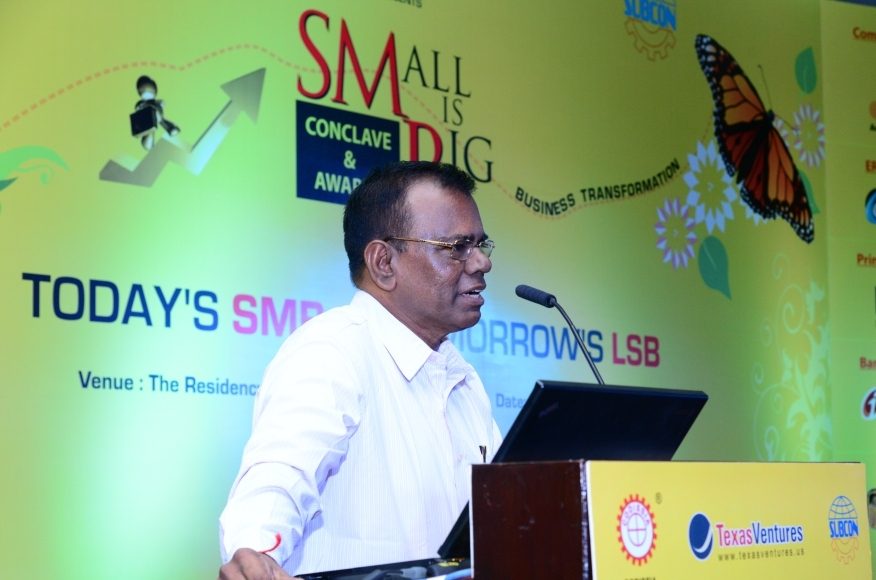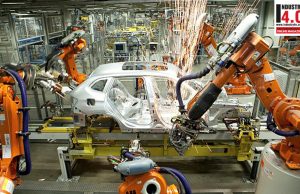DR. P. SIVAKUMAR Distinguished Scientist of DRDO, speaks to industry4o.com about Defence Manufacturing
Dr. P Sivakumar, Distinguished Scientist and Director of CVRDE, received “The Technology Leadership Award 2017”. The award was presented by Honorable Defence Minister Nirmala Sitharaman, Government Of India.
The award was conferred to him for his significant contributions in the design and development of transmission systems for armoured vehicles. Dr. P Sivakumar , has played a key role in the successful design, development, manufacturing, test evaluation, user trials and technology transfer and induction of the Arjun MBT Mk-I in the Indian Army.
After winning the award, Dr. P Sivakumar spoke to industry4o.com on his pursuits so far. You easily see the restlessness in the man to do something unique with technological advances in every project he is involved in.
You can’t but notice the childlike enthusiasm when he speaks about his pet projects. He has always been a man who is inspired by technology. There is a clear mindset of a champion in the way he goes about approaching tougher and technologically challenging project.
Congratulations on receiving the award. Were you surprised when your name was announced for the award?
No, I wasn’t surprised. It validates the hard work that has gone into the projects. The team at DRDO has always stood with me.
Your association with SME goes way back. And you might be aware that SUBCON 2018 is currently happening in Coimbatore. Just to ask you do think SME’s have a chance to survive against heavy manufacturing enterprise?
Yes SUBCON, organized by CODISSIA has aided SME’s & MSME’s to reach new milestones. But to me, there is no big and small. It’s how you approach manufacturing needs. Let me tell you this. Defence Research and Development Organization have always been indebted to the SME. Let’s not forget that it was the small SME’s that helped us way back in the 80’s. Today yes they may have grown. We never had big industries then who were working on projects with us.
Could you explain your point a little better or with an example?
The year was 1987 and that time I had Shanthi Gears (based out of Coimbatore) to manufacture high-speed gears. The management then said they may not be able to bear the high rejection rate. But they worked hard and today we know Shanti Gears are leaders in this field. They even manufacture for Aerospace requirements. They produced with Nominal Convention Ratios, today they produce products in High Conventional Ratios.
Just that you know that there are nearly 6000 MSMEs across the country supplying components and sub-assemblies to the DPSUs, Ordnance Factories, DRDO and private industries. We have been ably supported by the SME and MSME for the advancement of projects at DRDO.
Could you give me another example of an MSME in Tier 2 cities who are working with you and have seen their production capacity increase in recent years?
G VJ Engineering, Coimbatore is a great example of how MSME can take advantage of defence projects. GVJ today has attained technical maturity by working for Defence Components. They have graduated from 5kg a single component to 500 kg (single component) capacity wise. Now that’s a massive percentage rise. Now sustaining and enhancing their capacity, it has given the GVJ Engineering, a long-term business opportunity.
When we mention, about defence Manufacturing where or which product do you think there is a demand?
There is a major demand for mechanized forces (Vehicles), in no particular order these are the major potential demand where MSME can look to collaborate
- Future Infantry Combat Vehicle
- Future Ready Combat Vehicle (FRCV)
- 130 mm Arjun Catapult
- Armoured Repair and Recovery Vehicle (Arjun)
- Armoured Recovery Vehicle (T-90 based) Advanced Towed Artillery Gun System
- Wheeled Armoured Platform (WHAP)
Would you be able to share some statistics or market value that we are talking about? And what are the merging defence portfolios in electronics you expect growth in?
Aerospace & Defence industry expected to consume electronics worth $ 70-72 billion by the net next decade. Global electronics industry market is at $ 1.8 trillion. There are few emerging defence DRDO is excited about, they are
- Avionics
- High power lasers
- Radars
- Computing & communication networks
- Nanodevices
There are opportunities for startups who are in the verticals of High power electromagnetics & Nano facility.
In all of this is, how do you cope with change in requirement which The Indian Defence Force might suggest or change from time to time?
Well, that’s true, I can tell you this for a fact. In 2003, with the discussion the Indian Army was involved with DRDO, I wanted the Indian army to use my light vehicles way back. The army refused the proposal then. But today they want Light mobility tanks and vehicles as there is an increase in the insurgency. We constantly think what should be the Army’s need for the current scenario. We work on using Nanotechnology which will become critical to be used in light mobility vehicles. There is a change in the way Army looks at this. They now feel light tank is a must-have.
What scope of the partnership are we Looking between DRDO and MSME’s?
We want the MSME to improve their knowledge of design. They should also absorb new technologies and show us how technologies can be enhanced. So we are working on a lot of knowledge and information sharing platform. Our support to MSME is up to the extent funding for rejection rate. There is always a preference for MSME who are involved in development.
Talking of development, where do you get inspired to improve or enhance the ability of tools in MSME or just pure manufacturing?
I feel we don’t give nature its due credit. If we look at nature, it has already solved many a problem with ease. The flexibility of a manufacturing machine arm to turn more than 200 degrees is a challenge. Some scientist found the answer by watching the elephant’s long trunk. Maybe we should pay more attention to answers around us and constantly innovate. Imagination is always the key here.
Could you highlight the projects that defence ministry is taking up under Make in India initiative?
There are 23 projects that the defence ministry is taking up under the ‘Make in India’ initiative has 13 for Army, 6 for Navy and 4 in Indian Air Force. It’s the first time such a transparent modus operandi is been followed by the ministry of defence. This will allow participation of all categories of companies including MSME’s. Participation of MSME the government wants to encourage under Make in India. This is estimated between to be in the range of around Rs 2500-3000 crore in totality, the same is being viewed as an important step by the Indian government and is also the first of the lot after the announcement of the new Defence Procurement Policy (DPP) 2016. Moreover, some of these projects were earlier not open for private participation and were either manufactured by defence PSUs, ordinance factories or the demand was alternatively being met from imports.
Some of the high-end projects would include to name a few, 125 mm smooth bore gun barrel for T-72 & T-90 tanks with missile firing and improved ammunition, Individual Under Water Breathing Apparatus (IUWBA) for T-90 Tank, Mechanical Mine Layer (Self Propelled) Upper Air sounding system, Supersonic Aerial Targets, Diesel Engines for Propulsion, Diesel engine for Boats etc…
With SUBCON 2018 happening in Coimbatore, there is a buzz around manufacturing for defence. Do you have any word of advice for MSME’s in general?
I feel the buzz around defence manufacturing is good. But SME’s according to me, should look at multiple sectors to further their manufacturing prowess. Don’t limit to opportunities in defence alone. To improve production, Imagination is key. Having an imagination is far more important than having only knowledge. Imagination results in self-reliant and being independent.










